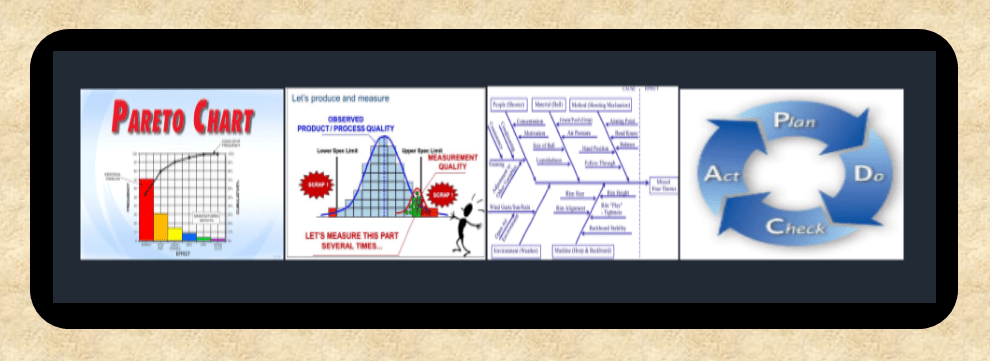Automotive Quality Techniques/Tools 1
Automotive Quality Techniques are well used in automotive industries to solve the vast majority of quality problems and initiate improvement measures in process i.e MSA studies.
1) Measurement system analysis MSA studies
- Meaning of MSA studies
- Purpose of MSA studies
- Characterization of MSA studies:
- Location (Average measurement value VS Actual value)
- Variation (Spread of measurement values precision)
- Measurement system analysis procedures
- Stability assessment
- Bias Assessment
- Repeatability and Reproducibility Assessment (Gage R&R method).
- Graphical representation of Repeatability Assessment (Gage R&R method)
2) Matrix techniques: the meaning of matrix techniques, uses of matrix techniques as a quality tool.
3) Pre-control techniques: the meaning of pre-control techniques, uses of pre-control techniques as a quality tool.
4) Benchmarking techniques:
- Meaning of benchmarking principles
- Why benchmarking?
- Types of benchmarking
- Hints on how to conduct critical steps in the benchmarking process.
- Essential steps to successful benchmarking principles in automotive industries.
5) Plan-Do-Check-Act (PDCA) techniques:
- Meaning of PDCA cycle, what is it?
- When to use the PDCA cycle, How to use it?
- Graphical representation of the PDCA cycle
- PDCA cycle: explanations.
6) Cause and effect diagram techniques:
- Meaning of Cause and effect diagram
- When to use Cause and effect diagram, How to use it?
- Graphical representation of Cause and effect diagram.
7) Control Charts techniques:
- Meaning of control charts
- When to use X-bar and R Control charts
- How does the control chart help to avoid defects
- A brief history of control charts
- Cause of variation: a. Common causes of variation
- Special causes of variation.
- Statistical Process Control –SPC- test rules. Graphical representation of the test rules.
Other four notable techniques and tools used in Automotive industries:
Measurement system analysis MSA studies
- Meaning of MSA studies
- Purpose of MSA studies
- Characterization of MSA studies:
- Location (Average measurement value VS Actual value)
- Variation (Spread of measurement values precision)
- Measurement system analysis procedures
- Stability assessment
- Bias Assessment
- Repeatability and Reproducibility Assessment (Gage R&R method).
- Graphical representation of Repeatability Assessment (Gage R&R method)
Advanced Product Quality Planning (APQP)
APQP is a structured approach to product and process design. This framework is a standardized set of quality requirements that enable suppliers to design a product that satisfies the customer.
The primary goal of product quality planning is to facilitate communication and collaboration between engineering activities. A Cross-Functional Team (CFT), involving marketing, product design, procurement, manufacturing and distribution, is used in the APQP process. APQP ensures the Voice of the Customer (VOC) is clearly understood, translated into requirements, technical specifications and special characteristics. The product or process benefits are designed in through prevention.
Failure Mode and Effects Analysis (FMEA)
Failure Mode and Effects Analysis (FMEA) is a structured approach to discovering potential failures that may exist within the design of a product or process.
Failure modes are the ways in which a process can fail. Effects are the ways that these failures can lead to waste, defects or harmful outcomes for the customer. Failure Mode and Effects Analysis is designed to identify, prioritize and limit these failure modes.
Production Part Approval Process (PPAP)
PPAP defines the approval process for new or revised parts, or parts produced from new or significantly revised production methods. The PPAP process consists of 18 elements that may be required for approval of production level parts. Not all of the elements are required for every submission. There are five generally accepted PPAP submission levels. The PPAP manual contains detailed information, guidelines and sample documents useful for completing the process requirements. The resulting PPAP submission provides the evidence that the supplier has met or exceeded the customer’s requirements and the process is capable of consistently reproducing quality parts.
Clients benefits: The training module will secure the clients to have the following benefits:
- Greater productivity is enhanced
- Smoother operations are ascertained
- Greater flexibility and responsiveness
- Eliminates defects (in-house and at the customer side)
- Reduce customer complaints like 8D
- Improve product quality
- Improve supplier quality
- Increased customer satisfaction
- Reduce returns of product
- Increase customer approval process and release of a production line within timeframe schedule
Who are the benefactors of these training modules or the target groups:
- Plant Managers
- Quality Managers
- Quality Engineers
- Production leaders
- Process engineers
- Quality Supervisors
- Quality Specialist
- Logistics
- Technology
- Production
- and others categories who are interested in leaning: Problem-solving techniques, Continuous improvement process PDCA, Benchmarking process, Statistical Process Control SPC philosophy, Advanced Product Quality Planning APQP, Production Part Approval Process PPAP for production lines release, leaning or engage in Measurement System Analysis MSA studies and carry out process documentation in their production plant effectively etc
The training modules acquire from Hermon Quality Solutions HQS services will help you to get your career professionals smoothly and efficiently. Why not give it a try and see the difference.
Let’s get in touch!!!

